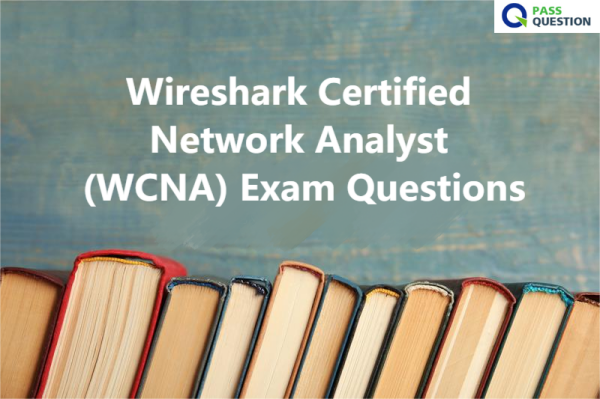Wireshark Certified Network Analyst (WCNA) Exam Questions
Are you worried about your WCNA Certification Exam? PassQuestion provides excellent quality Wireshark Certified Network Analyst (WCNA) Exam Questions that will help you in reaching your goal easily. Our Wireshark Certified Network Analyst (WCNA) Exam Questions will guide you on how you can clear the Wireshark WCNA exam easily on your first attempt. You can practice our Wireshark Certified Network Analyst (WCNA) Exam Questions before appearing in the real WCNA certification exam so that you can get an idea of the WCNA exam preparation and also will be able to sit confidently in the WCNA certification exam easily.

WCNA Certification Exam Overview
WCNA Certification (formerly referred to as the Wireshark Certified Network Analyst program) proves an individual's in-depth knowledge of TCP/IP and network/protocol analysis for troubleshooting communications, network optimization, network forensics, and security. The WCNA Certification Exam focuses on analyzing packets and protocols, for the purpose of network troubleshooting, optimization and security.
Successful completion of the WCNA Certification Exam (formerly referred to as the Wireshark Certified Network Analyst Exam) indicates you have the knowledge required to capture network traffic, analyze the results and identify various anomalies related to performance or security issues.To earn the WCNA Certification status, you must pass a single Exam—the WCNA-200.x Exam.The WCNA Certification Exam is available at hundreds of testing centers around the world.
Exam Information
Number of Questions: 100 questions
Duration: 2 hours (120 minutes)
Cost: USD 299
Format: true/false and multiple choice
Exam Areas
The four primary areas covered in this Exam are:
Wireshark Functionality
TCP/IP Network Communications
Network Troubleshooting
Network Security
WCNA Certification Exam Objectives
Section 1: Network Analysis Overview
Section 2: Introduction to Wireshark
Section 3: Capture Traffic
Section 4: Create and Apply Capture Filters
Section 5: Define Global and Personal Preferences
Section 6: Colorize Traffic
Section 7: Define Time Values and Interpret Summaries
Section 8: Interpret Basic Trace File Statistics
Section 9: Create and Apply Display Filters
Section 10: Follow Streams and Reassemble Data
Section 11: Customize Wireshark Profiles
Section 12: Annotate, Save, Export and Print Packets
Section 13: Use Wireshark’s Expert System
Section 14: TCP/IP Analysis Overview
Section 15: Analyze Domain Name System (DNS) Traffic
Section 16: Analyze Address Resolution Protocol (ARP) Traffic
Section 17: Analyze Internet Protocol (IPv4/IPv6) Traffic
Section 18: Analyze Internet Control Message Protocol (ICMPv4/ICMPv6) Traffic
Section 19: Analyze User Datagram Protocol (UDP) Traffic
Section 20: Analyze Transmission Control Protocol (TCP) Traffic
Section 21: Graph IO Rates and TCP Trends
Section 22: Analyze Dynamic Host Configuration Protocol (DHCPv4/DHCPv6) Traffic
Section 23: Analyze Hypertext Transfer Protocol (HTTP) Traffic
Section 24: Analyze File Transfer Protocol (FTP) Traffic
Section 25: Analyze Email Traffic
Section 26: Introduction to 802.11 (WLAN) Analysis
Section 27: Voice over IP (VoIP) Analysis Fundamentals
Section 28: Baseline “Normal” Traffic Patterns
Section 29: Find the Top Causes of Performance Problems
Section 30: Network Forensics Overview
Section 31: Detect Scanning and Discovery Processes
Section 32: Analyze Suspect Traffic
Section 33: Effective Use of Command-Line Tools
View Online Wireshark Certified Network Analyst WCNA Free Questions
1. What is the use of HTTP GET method?
A. To send data to a server to create/update a resource
B. To request data from a specified resource
C. To collect data from managed devices on IP networks.
D. Used for electronic mail transmission
Answer: B
2. Which of the following interfaces can not be used as a capture interface in Wireshark?
A. Bluetooth
B. Ethernet
C. Wifi
D. HDMI
Answer: D
3. Which function in Wireshark provides the summary of IPv4 and IPv6 packets?
A. Analyze
B. Capture
C. Telephony
D. Statistics
Answer: D
4. What is the purpose of using Display Filters in Wireshark?
A. Capture desired packets only
B. Show desired packets only
C. None of the above
D. Both A & B
Answer: B
5. Where can you find ‘Expert Information’ function in Wireshark?
A. Analyze
B. Tools
C. Statistics
D. Capture
Answer: A
6. Where can we do protocol specific settings in Wireshark?
A. Preferences
B. Configuration Profiles
C. Protocol Hierarchy
D. Conversations
Answer: A
- TOP 50 Exam Questions
-
Exam
All copyrights reserved 2025 PassQuestion NETWORK CO.,LIMITED. All Rights Reserved.

